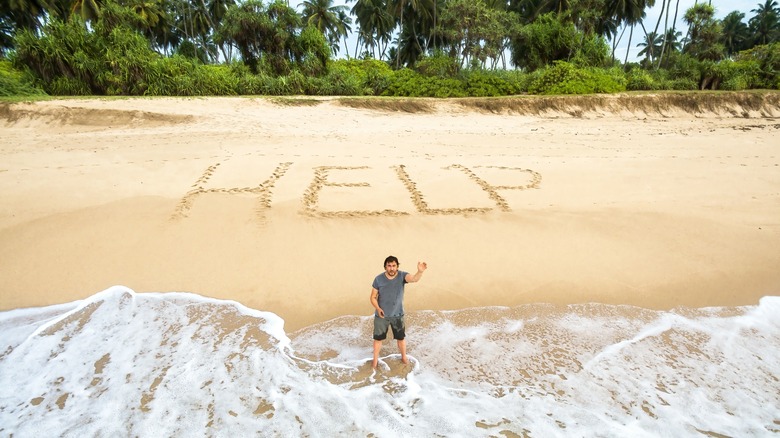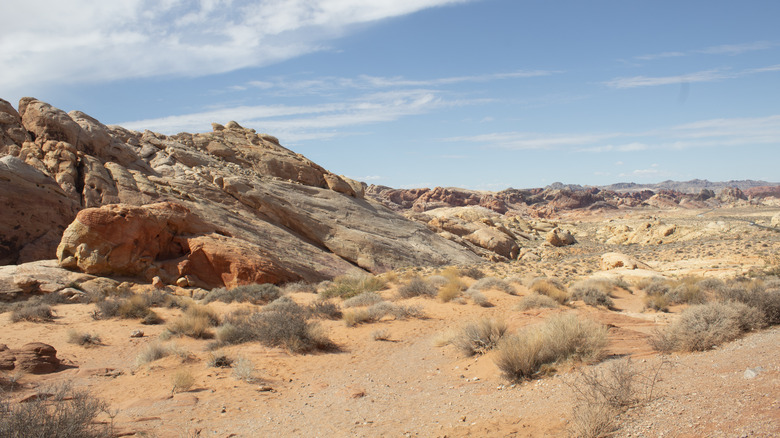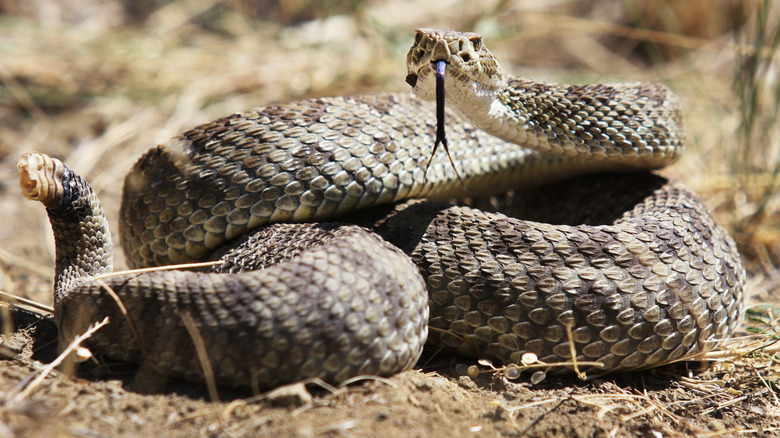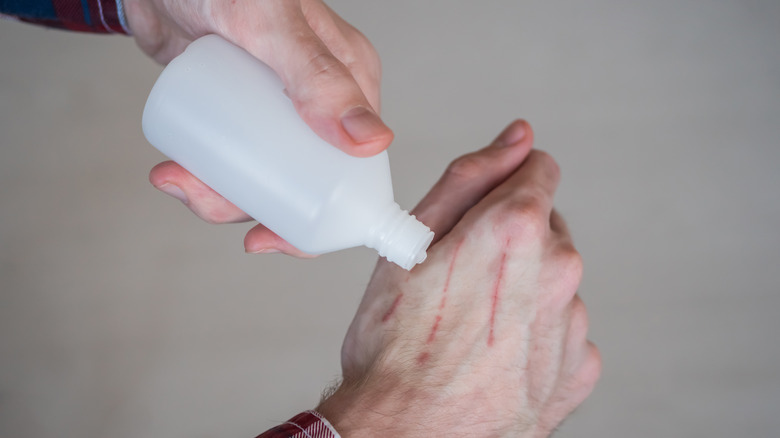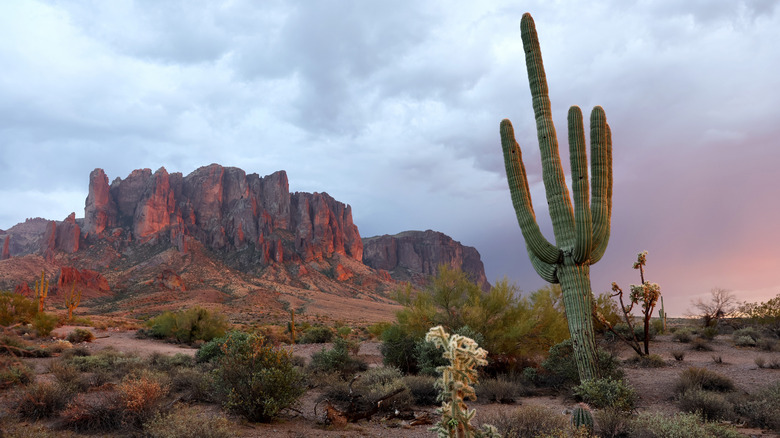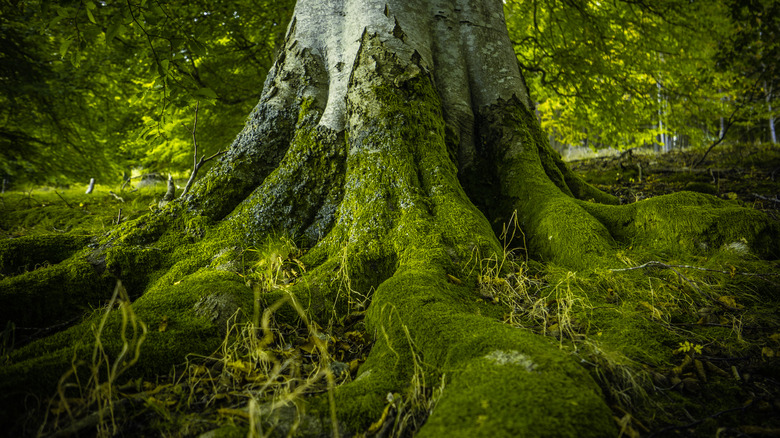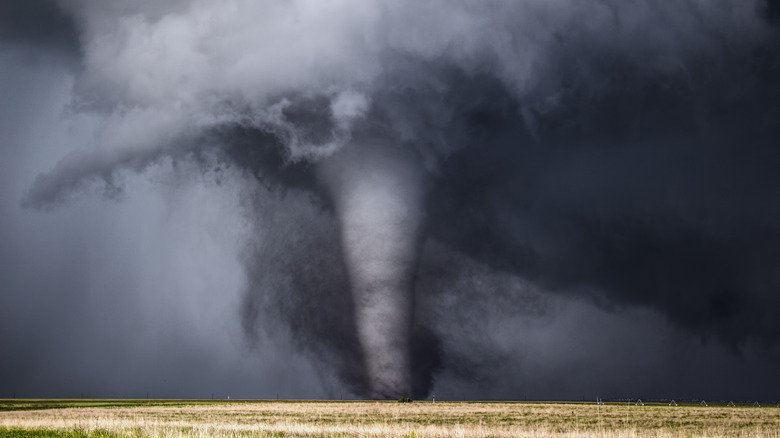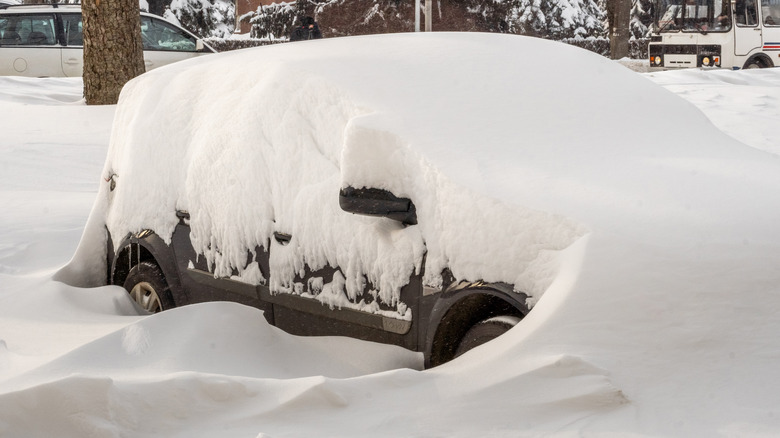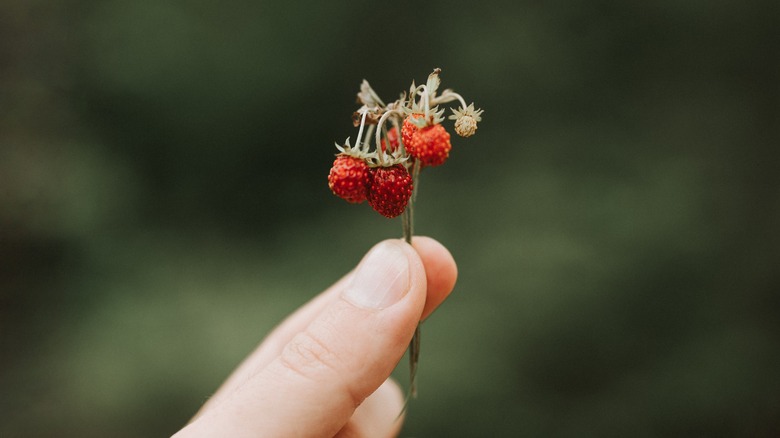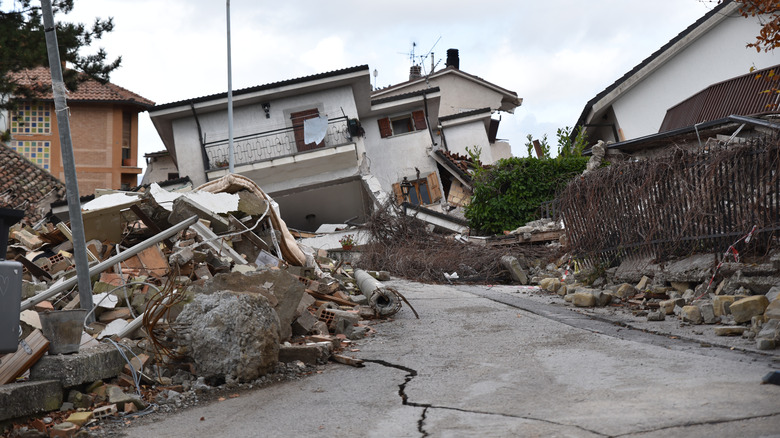Survival Myths That Could Actually Get You Killed
Maybe your car dies in the desert, leaving you stranded miles away from civilization. Maybe your plane crashed in the jungle, and you're the only survivor limping away from the wreckage. Maybe the power went out after a storm, or you're buried in snow, or deadly animals are lurking about. You have no cell reception and few supplies. Rescue may or may not be on the way, but for now, you're on your own. Or, maybe you just got hurt going about your day-to-day life, or the power went out after a bad storm.
You've seen scenarios like these in countless movies, TV shows, video games, and comic books. But while it's one thing to watch it all unfold from the comfort of your living room couch, next to a fridge stocked with food, it's a different story entirely when you're the one stranded in an emergency situation one day. Hopefully it'll never happen. But just in case, you'll want to know which common survival tactics you've heard your entire life are actually useful, and which ones are just urban legends that might be dangerous or even deadly. So let's bust some survival myths before they bust you.
MYTH: Drink your pee if you're dangerously thirsty
It seems to make sense. It's liquid, you're thirsty. Plus, Bear Grylls did it (via Discovery), and Saul did it in "Better Call Saul." And every once in a while, you'll come across stories in the news, where people drank their own urine to survive dangerous dehydration. That's the situation Mick Ohman found himself in, according to KFOR. "I was forced to drink my own urine at this point, in order to swallow," he told the outlet about what happened when his car died, leaving him stranded in a scorching desert. "It wasn't as obnoxious as I thought. It wasn't salty, and it quenched my thirst. But it was warm. Straight from the tap, I guess."
But WebMD warns against this. Your body got rid of the urine for a reason, so there's not much in it but a bunch of stuff that definitely won't help if you're dehydrated. In fact, by the time you're desperately thirsty enough to even consider it, the article maintains that your body is already so low on fluids that whatever comes out is going to be extremely salty and therefore far from the refreshing drink you need. And if you ingest too much sodium, you'll only get more thirsty, making the problem worse. The article also points out that drinking urine can lead to infection, unbalanced electrolyte levels, and even dangerous overmedication, as you're re-consuming whatever drugs you took earlier that your body just got rid of.
MYTH: Suck out the venom if you're bitten by a snake
This trope has appeared in several movies, TV shows, and video games. Someone gets bitten by a snake, so their friend cuts the wound, sucks out the venom, and spits it out. It's even happened in real life. Danny DeVito told "The Talk" (as explained by People) in 2018 that he employed this tactic on the set of "Romancing the Stone," saving costar Michael Douglas' life after a snake bite. And in 2015, KTXL reported that a pregnant San Francisco mom actually tried to save her son this way. "Mama Bear instinct in me decided to suck the venom out because that's what 'Bonanza' does," she said, referencing the TV Western.
But according to the article, she was lucky she didn't hurt herself or the fetus by doing this. "People don't really die from snake bites anymore," said Al Wolf, director of Sonoma County Reptile Rescue, via CBS Bay Area. "All the hospitals in the Bay Area have anti-venom," another expert, Laurie Osborn, said. "It's a pretty common thing."
WebMD cites a press release for a 2002 article in the New England Journal of Medicine, regarding snakebites. In it, physician Robert A. Barish writes that in the event of a snake bite, attempting to apply a tourniquet, suck venom out, or anything else you've seen in movies, can actually damage the wound even more, making recovery harder. Instead, skip the first aid attempts and focus on getting emergency care as quickly as possible.
MYTH: You should clean wounds with alcohol or hydrogen peroxide
Plenty of fictional stories have shown people cleaning nasty cuts and lacerations with alcohol, to kill any infection-causing bacteria that might be trying to get inside you via the bloody wound. And lots of people do this in real life too. Writing for USA Today, Dr. Michael Daignault says he's seen a worrying TikTok trend of people cleaning cuts with hydrogen peroxide, marveling at how the wound fizzes because they think it's a sign of the cut being cleaned. He also says lots of people he's treated for cuts and lacerations over the years say they applied hydrogen peroxide because their parents and grandparents told them to. But he really wishes they would stop.
"While hydrogen peroxide does have known antiseptic properties, it may do more harm than good when it comes to wound care," he writes in the op-ed. "The bottom line is that hydrogen peroxide and other caustic first aid antiseptics like rubbing alcohol should not be used to clean fresh open wounds."
Cleveland Clinic concurs, saying that both hydrogen peroxide and rubbing alcohol can cause further harm to healthy tissue that's already damaged and sensitive because of the wound. Naturally, this only makes recovery a longer and harder process than it has to be. Instead, soap and water are perfectly capable of cleaning out harmful substances before a bandage can be applied or, in the case of particularly serious wounds, a professional can treat it.
MYTH: You should ration water in emergency situations
Cutting back your consumption of scarce resources in desperate situations is often necessary. You don't want to eat more than you need if you don't know where your next meal is coming from, after all. So it follows that as thirsty as you might get if you're stuck in the desert, lost at sea, or without power, you should only allow yourself a sip or two of water when you're about to collapse from thirst.
But this is actually a bad idea. FEMA advises you'll need to drink at least a half gallon a day if you're healthy and in a comfortable environment. But that won't always be the case. And even if you're not in sweltering heat and nobody you're providing for is a child, nursing, or sick, that doesn't account for the water you'll need for washing and cooking, among other things. Thing is, there is simply no scenario where you survive a long time in an emergency situation without adequate water supplies. Drink whatever you need now, and make finding more a priority for tomorrow. Then, reduce water needs by staying as cool as you can and reducing physical activity if possible.
That being said, Very Well Health notes that you can stay hydrated while still keeping an eye on the supplies. Don't ration water, but only drink if you're actually thirsty. As it points out, the whole "eight glasses of water per day" thing is also a myth.
MYTH: Dehydrated? Drink from a cactus
You're in a desert. It's hot. Your mouth feels like sandpaper. There's a cactus. You have a knife. Everyone knows cacti have water in them. So crack one of those bad boys open and have your fill.
Actually, not so fast. Britannica reports that the fluid inside cacti isn't water, because basic natural selection says thirsty desert critters would've eaten such plants into extinction long ago. What you'll actually find if you chop them up for a drink like a movie cowboy will make you sick, sometimes violently so. It does mention that some possible exceptions might be the prickly pear or barrel cactus species, but even these aren't ideal unless you're out of options and desperate.
Creek Stewart goes into more detail in a video for The Weather Channel, pointing up at a towering barrel cactus and asking, "Does that look like a plant that's gonna give up something precious without a fight?" After describing how the plants are actually protected in the U.S. (meaning you might get in legal trouble if you try to drink from one), he chops one open to reveal, instead of water, tough, acidic, alkaloid-filled flesh that you'd really have to try to wring some water out of. "Oh, that is nasty," he says after getting a pitiful drop or two. "Rather than quench your thirst, it's probably just gonna make your stomach upset, give you some nausea. Definitely things you don't want in a survival scenario."
MYTH: Moss only grows in the north part of the tree trunk, which helps navigation
Being lost in the woods is understandably a common fear for many. But if you ever find yourself separated from your hiking group, just know there are some helpful techniques to help you orient yourself and get back to safety. And you don't even need a compass! For example, moss only grows on the north side of a tree, which will help you navigate.
Well, kind of. Encyclopedia maintains that some moss does actually prefer the north side of trees in the Northern Hemisphere, because the sun tends to be in the southern part of the sky, making that side hotter and dryer and thus less friendly to that type of plant. However, it also points out there are enough exceptions to this rule that you shouldn't rely on it to navigate if you're lost in the woods.
That's exactly what the Backpacking Biologist found when he went into the forest in Felton, California, to test the theory himself. There was moss only growing on one side of many of the Douglas firs that dotted the landscape, but when he pulled out his compass, he only found one tree featuring moss that was pointing north. "Moss is not just going to tell you where north is," he says. "We learn that moss grows on the wettest side of the tree ... And the problem is that, in the forest, you can have many different sides that are wet."
MYTH: Punch sharks in the nose if you're under attack
You might've heard that if you're ever attacked by a shark, the best way to get it to flee before it devours you is to give it a solid punch right on the snout. But this is actually a great way to get yourself badly maimed, or worse, according to The New York Times. As zoologist and director of British Columbia's Reefquest Center for Shark Research, R. Aiden Martin, told the outlet, "If you miss the snout its mouth is unfortunately very close by." Instead, go for even more sensitive areas, like the eyes or gills.
Shark researcher Ryan Johnson concurs, telling the BBC that trying to smack the shark on the nose might actually give the fish the impression that you are edible after all, since you're sticking your hand around its mouth. Instead, he says you should use "something hard — be it a camera, a stick, a rock" — to nudge the animal away from you. If that's not available, keep your hands as far away from its mouth as possible, and fight for your life.
Luckily, you probably don't need to worry about getting attacked by a shark any time soon. The Florida Museum reports that only 57 unprovoked shark attacks were confirmed in 2022, which is pretty dang low considering how many people live near water and like to go to the beach. Meanwhile, tragically, humans kill an estimated 100 million sharks per year, according to a study published in Marine Policy.
MYTH: If a tornado is coming, get under a bridge or highway overpass
In movies like "Twister" and "Man of Steel," people survive tornadoes by taking shelter under bridges and highway overpasses. And in real life, a news crew survived a deadly April 1991 tornado in Kansas by hiding under an overpass. You can see the video of it here, from the show "Code 3."
But the National Weather Service insists, in a presentation detailing a deadly 1999 tornado outbreak in Oklahoma and Kansas in which several people died hiding under an overpass, that such structures provide "at best, questionable shelter" from tornadoes and other severe storms. That video of the 1991 incident led to huge numbers of people erroneously placing their faith in overpasses, but the crew only made it out alive because of a number of unique circumstances and "a bit of luck."
So why wouldn't having several feet of concrete over your head help you if a twister is coming? The same presentation reports that tornadic winds aren't contained to the funnel itself and don't only go up (something which much of the deceived general public believes would be blocked by an overpass). Instead, the winds often move horizontally and actually increase underneath bridges and overpasses, creating a "wind tunnel effect" and rendering overpasses and bridges not just useless as shelters, but arguably worse than being out in the open. Instead, if you're outside and you can't make it to shelter, try to find ground that's significantly lower than the roadway, lie there, and keep your head covered (per the Ohio Committee for Severe Weather Awareness).
MYTH: Eat snow if you're dangerously thirsty
Pulling from Swedish news outlet Aftonbladet, The Guardian reports that a man was rescued in 2012 after spending an astonishing two months trapped in a snowed-in car. He had good clothes but no food, and only survived that long because the "igloo effect" kept his vehicle relatively toasty, and by eating snow for nourishment. It's obviously an incredible story, and doctors at the time said humans couldn't have lasted much longer without food.
But don't go thinking you can survive indefinitely by just eating snow. First, The Washington Post reports that while most snow is probably fine, you should be aware that it might contain some unwanted ingredients. These can range from rock salt, if you're picking it off a street or sidewalk, to animal waste, to pollutants in the air, to certain types of algae. But that's for a fun snack.
The biggest issue is for anyone who might be eyeing the stuff in an emergency survival situation. As FEMA points out in this wilderness survival guide, eating snow can actually make you more dehydrated. If you're thirsty and stranded in a wintery environment, try to find ice instead. It takes a lot less effort to melt. And if you don't melt it before eating some, Sportsman's Guide maintains it can lower your body temperature, risking hypothermia. Furthermore, that site suggests that, since snow is mostly air, you'll need more than you think to get a decent amount of water out of it.
MYTH: finding food is priority #1
You're stranded in the wilderness with no cell reception or supplies. Rescue may or may not be coming. Quick, what's the first thing you need to do to make it through this? If you've watched a lot of wilderness survival movies, your answer might be to find food as soon as possible. After all, you don't want to be scaling cliffs or fighting off mountain lions on an empty stomach. But in reality, food isn't even close to your top priority.
In its brief guide to 24- to 48-hour survival, FEMA describes the "Rule of 3s." In a nutshell, you can go three minutes without air, three hours without shelter, three days without water, and three weeks without food. Therefore, you need to make sure you're protected from the elements with access to fresh water well before worrying about your next meal. In fact, the guide doesn't mention food much at all other than that the guide is for a period of time short enough that "food should not be a factor." If you're stranded for longer than 48 hours, it recommends, eat any healthy animal as long as you cook its flesh.
According to Scientific American, how quickly someone will starve to death depends on many factors, most importantly their hydration levels. If a hungry person still has access to water, they can survive for longer than you might think. Nobody is recommending trying this, but it underscores the importance of hydration.
MYTH: In an earthquake, take shelter in a doorway
In 2015, the Portland Press Herald reported that Alison Hudson survived a terrifying earthquake and the resulting avalanche in Kathmandu, Nepal. She only survived the disaster because she huddled in the doorway of her apartment for hours while everything came crashing down around her. Had it not been for that and her quick thinking, she might've been buried in rubble.
But you should be very careful about trying this yourself. According to San Bernardino County, there used to be some merit to the idea that doorways are the safest place to be during earthquakes, because they used to be the most structurally sound part of many houses and were often the only thing left standing in the aftermath of big quakes. But that was before modern construction standards changed the game. Today, houses are much sturdier and less prone to collapse, and doorways are no longer any stronger than other parts of the building. Furthermore, violently swinging doors could be hazardous. Instead of hunkering down in a doorway, the article recommends that you "drop, cover, and hold" beneath tables or desks if inside. If you're outdoors, get as far away as possible from outside windows, trees, or power lines.
The CDC concurs, and adds another reason to avoid doorways during earthquakes: They don't protect you from flying or falling objects, which are now the most common cause of earthquake-related injuries since fewer buildings are collapsing.
